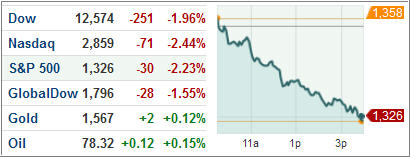The major index ETFs took the year’s second hardest knock Thursday losing more than two percent as investors ran for safe haven assets amid indications of a global slowdown, while rumors of an impending downgrade of 17 major US banks by Moody’s Analytics added to market concerns.
Obviously, disappointment in what the markets perceived as a lack of Fed intervention played a big role and added to downward momentum. Again, my view is that the Fed will not pull out the big guns, if it has any left, until the markets dive towards panic territory or the economy slips officially into a recession. My definition of panic in the markets would be another 20% or so correction from current levels putting the S&P 500 towards the 1,000 milestone.
Treasuries progressed for the first time in three down sessions after Europe’s PMI index for June remained near three-year lows while manufacturing output in Germany, the region’s biggest economy, slowed down at the fastest rate in three years and manufacturing shrank for the eight month in Asia and China. The global slowdown is now underway, and the US market will not be excluded from its effects.
The Dow Jones Industrial Average (DJIA) plummeted 251 points and the S&P 500 Index (SPX) dropped 30 points with energy fronting the laggards while utilities fared the best among its 10 business sectors.
According to data released by the US Labor Department, 387,000 first-time unemployment benefit claims were filed, marginally higher than 380,000 projected by Briefing.com.
Against economists’ forecast of a 0.2 percent drop, the Philadelphia Fed’s manufacturing index contracted sharply by 16.6 percent. However, the Conference Board’s leading economic indicators index for May was the lone bright spot, rising 0.3 percent after dropping 0.1 percent in April.
Elsewhere, data released by the National Association of Realtors showed existing home sales came in slightly lower than expected at an annualized rate of 4.55 million units.
Risk appetite was further diminished after Goldman Sachs advised investors to short the S&P 500, indicating current levels are overpriced by about 5 percent. The 10-year benchmark Treasuries shed four basis points to 1.61 percent in late afternoon trade, New York time. Yield on 30-year bonds closed six basis points lower at 2.68 percent.
ETFs in the news:
The Barclays iPath DJ-UBS Natural Gas Subindex Total Return ETN (GAZ) were among the best performers, adding 3.76 percent for the day. GAZ is up nearly 10 percent for the week, after surging about three percent in the prior week.
Some analysts believe Natgas has bottomed out as producers cut output in response to falling prices. On the other hand truck operators and utilities are switching to NG to take advantage of lower prices. Prices of natural gas may surge leading to a bull run towards the end of the year, analysts believe.
As investors fled the stock market on souring risk sentiments, the ProShares VIX Short-Term Futures ETF (VIXY) vaulted 11.37 percent. VIXY gapped higher from the beginning of the day’s trading session while the benchmark CBOE Volatility Index surged 16.47 percent.
The Van Eck Market Vectors Junior Gold Miners ETF (GDXJ) crashed 7.73 percent, ending up among the worst performers. Gold prices tumbled more than $50 an ounce while silver dropped by more than 5 percent on the day as USD rallied and the euro slipped on news that Madrid may require an additional €62 billion to recapitalise its troubled banks.
The Global X Silver Miners ETF (SIL) also tanked, losing 6.74 percent on the day.
Our Trend Tracking Indexes (TTIs) retreated with the market, and I will update the numbers and charts in the StatSheet, which I will post within the hour.
Disclosure: No holdings
Contact Ulli

Comments 2
GREAT WEBSITE — THANKS FOR THE SUMMATION
I APPRECIATE YOUR VIDEO AND WRITTEN SUMMATIONS.